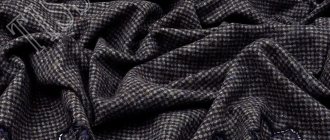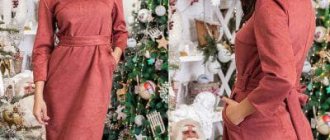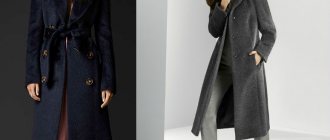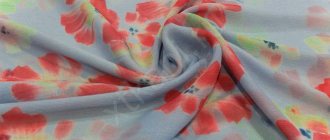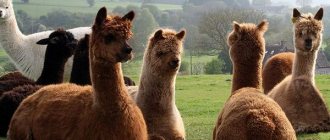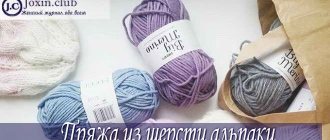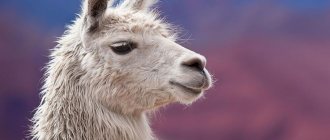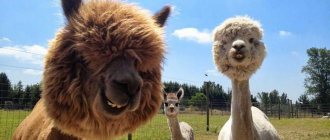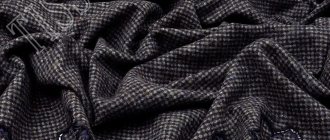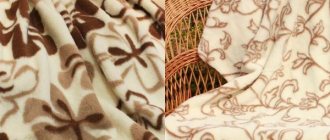Alpacas are rare animals with wool of unique quality. They live in the Andes mountains. Residents of these places have long used alpaca wool to make clothing. Since foreigners appreciated its unique qualities, wild animals have become scarce. Alpacas are now bred in nurseries. The wool, which is sheared once a year, is used to make knitwear and woven materials. The products have the same names.
Cute animals with unique fur
It’s as if they came down to us from another planet. Fluffy creatures with beautiful delicate fur and funny faces that attract both children and adults. The alpaca animal is like a picture of goodness, purity and peace.
The legend of the descendants of the Incas says: “When the Ancestress of the people of the whole world descended from heaven to earth, she had with her an alpaca, which she chose for its harmless disposition and unusual appearance.” The Indians adored this creature, which was sent by the gods. And only the upper strata of the population could use its fur.
For a long time they were combined into one species with llamas, despite the fact that they differ in size and appearance. In 2001, scientists discovered that animals have different parents. They were identified as a separate species.
The alpaca and the value of its fur received positive publicity in 1836 thanks to an Englishman. He noticed a bale of wool on a farm and began experimenting. He produced a nice and neat fabric, which is still called alpaca (the same name as the artiodactyl species).
The main habitat is Peru. But recently, they have been bred by farmers in other countries: Belarus, Australia, Italy, Russia, USA, New Zealand. They live in herds, eat grass and fruits, and use their food sparingly. Farmers keep alpacas not only for their valuable fibers, but also for tourism purposes: children and their parents love to admire the cute relatives of camels.
People liked the appearance of Peruvian animals so much that the “rainbow alpaca” was invented. This is a multi-colored toy made of plush artificial material.
What makes wool unique?
These animals live in the mountainous regions of South America.
There is a large amount of natural wool raw material obtained from various animals. Among them, alpaca stands out for its special qualities, thanks to which it has been highly appreciated by consumers.
The secret lies in the specific climatic conditions of the animals’ natural habitats:
- In the mountains of South America, air temperatures fluctuate throughout the day within a range reaching 30 °C.
- Air has a special composition and density.
- Alpacas feed on mountain grasses grown on soil with specific minerals.
All this affects the composition and structure of the coat.
Alpacas have difficulty adapting to other places. Despite the most active attempts to raise animals in nurseries in different countries, few have been successful. It is not possible to breed them in Europe and Africa. The island climate of Britain turned out to be more acceptable. There are 60,000 alpacas living there. About 10,000 migrants adapted to Australia.
To increase the number of alpacas, they crossed with their closest relatives, llamas. The offspring easily adapts to life in nurseries, but cannot reproduce with their own kind.
Alpaca wool
Polar bear fur is similar to alpaca wool in texture and quality. When the temperature drops, the fibers expand, and when the temperature rises, they contract. And due to the fact that the fibers are hollow, the material has high thermal insulation characteristics.
Production
Peru is the main supplier of alpaca yarn. In its pure form, without impurities, this is an expensive pleasure, since animals are usually shorn once every 1.5-2 years. Snow-white albino alpacas were bred through selective breeding. Yarn of this color is the most expensive. In total, there are more than 20 natural shades in nature: black, brown, sand, gray, burgundy, chocolate, etc. Terracotta is the most popular natural color, and blue-black is very rare.
One artiodactyl produces on average 4-6 kg of raw material per year. Processing occurs in five stages:
- cutting and sorting (depending on the breed and color, excess fibers of a different tone are manually removed);
- cleansing of dirt and debris (there should be no leaves or hay in it);
- twisting yarn (it must first be combed);
- cleaning the resulting cut;
- if necessary, dyeing (white raw materials are valued because they can be dyed any color).
Fibers can be light or heavy. It all depends on how they were twisted. Summer clothes are made from weightless material (it keeps cool well). Fluffy and thick - warming and durable products.
Alpaca wool is 7 times warmer than sheep wool!
Properties
People who are far from sewing and needlework do not immediately believe that there is wool that can repel water, warm in winter and cool in summer. But “getting to know” the alpaca removes their skepticism.
Unlike sheep fur, there is no lanolin, which causes allergies in some people. This allows the clothing to be worn by young children and people with autoimmune diseases.
Lanolin is an animal wax obtained by boiling wool.
The hairs themselves are long, strong and soft. The quality of yarn depends on the sex, nutrition and age of the animals. Shearing one large male can bring 10-12 kg of wool per year, and females - 2 times less.
Varieties
Alpaca is a generalized name for the wool of artiodactyls of the same name. There are two types of these animals in the environment, which differ in appearance and quality of fur.
Huacaya is a plush alpaca. This feature is obtained due to the growth of hairs perpendicular to the skin. The wool of this breed accounts for about 9% of world production. It is more accessible and budget-friendly.
Suri is a small breed of alpaca. Their fur is similar to silky dreadlocks or braids, and the fleece is thick and uniform. Products made from suri are expensive and valuable. Fashion designers and high-income segments of the population can afford them. Branded clothing is made from such textiles.
Armani has repeatedly used suri products in his shows.
Depending on the thickness of the animal’s hair, yarn is divided into several types:
- royal (18-20 microns);
- baby (20.5-22.5 microns);
- very soft (22.5 microns);
- adult alpaca (32 microns);
The thinner and more delicate the threads, the more comfortable and delicate the items.
Production
To obtain valuable raw materials, animals are sheared once a year. After that, it is sorted by hair length. Then I make yarn from the best raw materials, and after that the finished fabrics are knitted. The most valuable fabric is baby suri alpaca, which is made from the fur of young animals of the suri breed. It is soft, thin and smooth because it does not have characteristic curls. The entire yarn making process is done by hand, starting with fiber sorting and ending with spinning.
On topic: Merino wool - what it is, you will find out in another article.
Fabric: pros and cons
Buying alpaca yarn or fabric is a decision you won't regret. Knitted or sewn clothes not only look beautiful and elegant, they also have a number of advantages.
- Long fibers prevent pilling from forming. The outfit looks neat and expensive.
- Comfortable to wear: the body breathes and does not sweat.
- It has a noble shine and does not contain a specific wool smell.
- Pleasant and uniform texture. An outfit made from alpaca fabric does not itch the skin, which happens with sheep and camel wool. It is weightless and comfortable.
- Hypoallergenic. This property allows all people to wear clothes.
- Mixes well with polyamide, viscose and cotton. This reduces cost but maintains value.
- Medicinal properties. Well suited for people with diseases of the spine, circulatory and cardiovascular systems.
- The fibers repel dirt and water.
Products made from this natural raw material have much fewer disadvantages:
- clothes can wrinkle easily;
- You should “protect yourself” from moths only with natural remedies: lavender, wormwood, etc.
- The “purer” the composition, the higher the cost.
The price does not scare people, since the items will withstand more than one year of use. They will not lose their shape, will not fade and will delight their owner for a long time.
The history of the origin of alpaca fabric
Several thousand years ago, alpacas were domesticated by the inhabitants of the South American Andes. During the Inca Empire, their wool was the local currency and was valued for its unique color as well as the highest quality.
Unfortunately, when the Spaniards came to South America, they did not appreciate the properties of the wool of these animals and began to breed sheep. Alpacas only returned to popularity in 1984, when animals from Chile began to be imported to the United States.
Today, the largest supplier of alpaca wool is Peru. They produce about 4,000 tons per year, while the fibers from the animals are cut once every two years.
Alpaca products
The wool fibers of these noble artiodactyls are thin but dense. This makes painting and processing of raw materials easier.
Down is used for knitted and woven clothing, and rugs, bedspreads, carpets, etc. are made from coarse fibers.
Jackets, cardigans and pullovers
In winter, it is important that your clothes are warm and cozy. Typically, fur causes irritation and discomfort. Children are “afraid” of itchy clothes. But alpaca sweaters or cardigans are tactilely pleasant and soft. Therefore, both kids and their parents will be comfortable and warm in such things.
Needlewomen love to knit pullovers and jackets from feather-soft yarn. The result is long-lasting outfits that can be passed down from generation to generation. They can be unraveled and retied.
Experienced craftswomen recommend drop alpaca - a soft thread for children's clothing.
Popular handmade models:
- basic jumper with dropped armhole (fits well and is easy to knit);
- sweater with raglan sleeves (acrylic is most often added to the composition);
- wrap-around cardigan (can be worn in the off-season);
- turtleneck (fits nicely to the body, protects from the cold);
- premium vests made of suri (expensive clothing for business meetings).
An alpaca jacket is a great option for fall. It is light, soft and fluffy. Often tailors combine such fabric with artificial leather.
Haberdashery
It’s terribly unpleasant when, in the bitter winter, a hat and scarf create discomfort: the neck and head itches, which causes redness on the skin. Soft alpaca yarn does not cause discomfort.
Handmade works made from delicate fibers are in demand in the autumn-winter period. Indeed, in addition to comfort, hats, gloves, mittens and scarves do not roll down and do not get wet as quickly as happens with products made from other raw materials.
Users note that socks and knee socks made from this material are ideal for use. They do not wear out for a long time, do not stretch and keep your feet warm, which protects against hypothermia.
Home textiles
What could be more pleasant than coming home from work in winter and wrapping yourself in a soft and fluffy blanket? You can cover a sleeping baby with such a blanket and not worry. After all, the material is hypoallergenic, dust mites do not grow in it, and the child is kept dry and warm.
Cushion covers, shawls and blankets are popular home textiles made from Peruvian artiodactyl raw materials. The rich color scheme will appeal to any aesthete who can spend time with a book, take such a thing on a picnic or on a trip.
Warm blankets not only provide warmth, but also have healing properties. They are effective for radiculitis, osteochondrosis, etc. And bactericidal properties protect against the development of fungi and microbes in home textiles.
Coat
What are coats made from? For warm weather, choose thin and light fabrics: gabardine, crepe, felted knitwear. Durable wool or wool blend fabric is suitable for winter: boucle, drape and, of course, alpacas. The last option is a profitable investment that will delight its owner for more than one season. The alpaca coat is practical, elegant, windproof and does not get wet.
How to sew outerwear from alpaca material?
The ideal fabric for a coat should hold its shape, protect from the elements, hide imperfections and highlight the beautiful lines of the body. You can buy such things, but if you create them yourself, it will be more economical and individual.
A simple coat without darts or lining is easy to sew yourself. No pattern needed. Alpaca is a reversible material that fits perfectly.
- We take measurements: chest, hips, waist, neck, shoulder and sleeve length.
- Parts of the shelves and back must correspond to the width of the half-circumference of the hips + 5 cm. To build a one-piece sleeve, you need to measure the width of the shoulder from the neckline and add the required sleeve length.
- To build a collar, you need to measure a line of material along the length from the neckline.
- The side stitches, hem lining and collar are sewn on a machine.
- You can sew and stitch the removable belt separately.
Check the cut for shrinkage first!
Popular models
A variety of styles, textures and shades can be seen among outerwear made of any material, including alpaca. 100% natural wool of Peruvian animals does not need dyeing, as there are more than 20 colors in nature.
- Loose-fitting coat and short coat. These models are suitable for ladies with curvy figures. An outfit made from this material looks discreet and stylish. And to add a “zest” you can decorate it with a brooch, sequins, and beads.
- The fitted model emphasizes the curves of the female body, and the alpaca texture does not add volume. The ideal length is maxi or midi.
- With a hood. A good option for those who don't like hats. The product does not get wet and protects from the wind.
- Combined outerwear. Firstly, it will be cheaper. Secondly, different textures always look interesting. Alpacas are combined with suede, drape, and corduroy.
- Knitted cardigan coat. It can be created from yarn. It is suitable for cool spring or early autumn.
- Jacket-coat. A good strict option that will save its owner in a cold office.
- Oversized. This season the “man’s shoulder” model has been popular on fashion platforms. Voluminous, wide outerwear allows you to hide figure imperfections.
Alpaca fabric or yarn is suitable for any style of coat. Its texture is delicate and tactilely pleasant.
Artificial alpaca
Wealthy people can afford things made from natural fur from Peruvian animals. But what to do if you want to be in trend, but finances don’t allow it? Artificial materials or a mixture of alpaca and synthetics come to the rescue.
Externally, clothes made from these materials are difficult to distinguish from each other. They are equally soft, fluffy and presentable looking.
An artificial coat or jacket is several times cheaper. It does not have high thermoregulation, the skin in such things can sweat, and bright unnatural colors are often found. In order to hide the budget of the outfit, you should choose calm natural tones: sand, beige, gray.
Application
Things and products made from alpaca wool are very warm, so they are widely used in the manufacture of winter and demi-season outerwear. Coats, blankets, and alpaca wool ponchos are made from the wool of adult individuals. In addition, warm children's clothing is made from unique yarn, which is absolutely hypoallergenic. Read about all the materials for coats, shirts and skirts in the “Clothing” section.
Lifehacks for caring for things
Alpaca textiles are delicate and “picky” to care for. In order not to spoil it and extend its service life, you need to take good care of it.
- It is better to dry clean pure wool, and wash mixed wool at a temperature of 40-50 degrees.
- Use mild, gentle powders or shampoo.
- Unscrew slightly, without using force.
- If there is a small stain on your outfit, you can take a dishwashing sponge and wash it off.
- Ironing occurs only through a cotton sheet or gauze. The product does not need to be pulled, otherwise it will become deformed. Iron temperature - 140-150 degrees.
After the summer season, clean outerwear should be hung and ventilated on the balcony. If the alpaca has a large pile, then you can carefully comb your coat or sweater with a brush.
100% wool is food for moths. But chemicals are not suitable for controlling the parasite. And branches of cedar or lavender are a salvation for your wardrobe and a pleasant aroma as a gift.
Knitted pullovers, jackets and cardigans cannot be hung on hangers. Otherwise they will become deformed.
Capricious skeptics, allergy sufferers and small children enjoy wearing outfits made from these natural fibers. The high price is justified. After all, you can wear an acrylic sweater or a bouclé coat for 1-2 seasons. And alpacas are an eternal, ecological natural material. The skin will be delighted, and the body will forget about the feeling of cold.
How to preserve unique properties? Care
Caring for alpaca products is not particularly difficult, but requires certain subtleties. First of all, the rule “you wear it every day and wash it” is not observed in this case. Since alpaca wool practically does not absorb dirt, it is recommended to wash items made from it only after they have been worn at least seven times.
- It is recommended to wash by hand using cool water and mild detergents.
- There is no need to unscrew the products, you just need to let the water drain, carefully straighten them and lay them out horizontally.
You can even wash a coat in exactly the same way, after which you need to iron it from the inside out through a damp pad and comb the pile with a brush. It is better to take an expensive item to the dry cleaner. However, such a need rarely arises; in most cases, a coat or suit restores its appearance by “dangling” on its hangers.
It should also be remembered that the properties of alpaca deteriorate when in contact with chemical repellents.
Therefore, when storing such a thing in the closet, use only natural repellents.
